Marketing and Management: Analysis of Distribution and Logistics
VerifiedAdded on 2022/10/06
|10
|2589
|199
Report
AI Summary
This report delves into the realms of marketing and management, with a specific emphasis on physical distribution, logistics, and supply chain management. It begins with an introduction to the field, highlighting the significance of physical distribution and logistics as pivotal components of the marketing mix, influencing channel strategy and competitive advantage. The report then reviews three articles, providing background information and summarizing their major findings. Key concepts such as order processing, customer service, and the integration of technology in supply chain management are discussed. The report further identifies research issues within the articles and explores the managerial implications of the findings, emphasizing the importance of customer-oriented strategies and efficient logistics for achieving sustainable competitive advantage. Finally, it underscores the significance of effective planning and implementation in distribution processes, emphasizing the role of third-party logistics operators and the need for transparency in reporting.
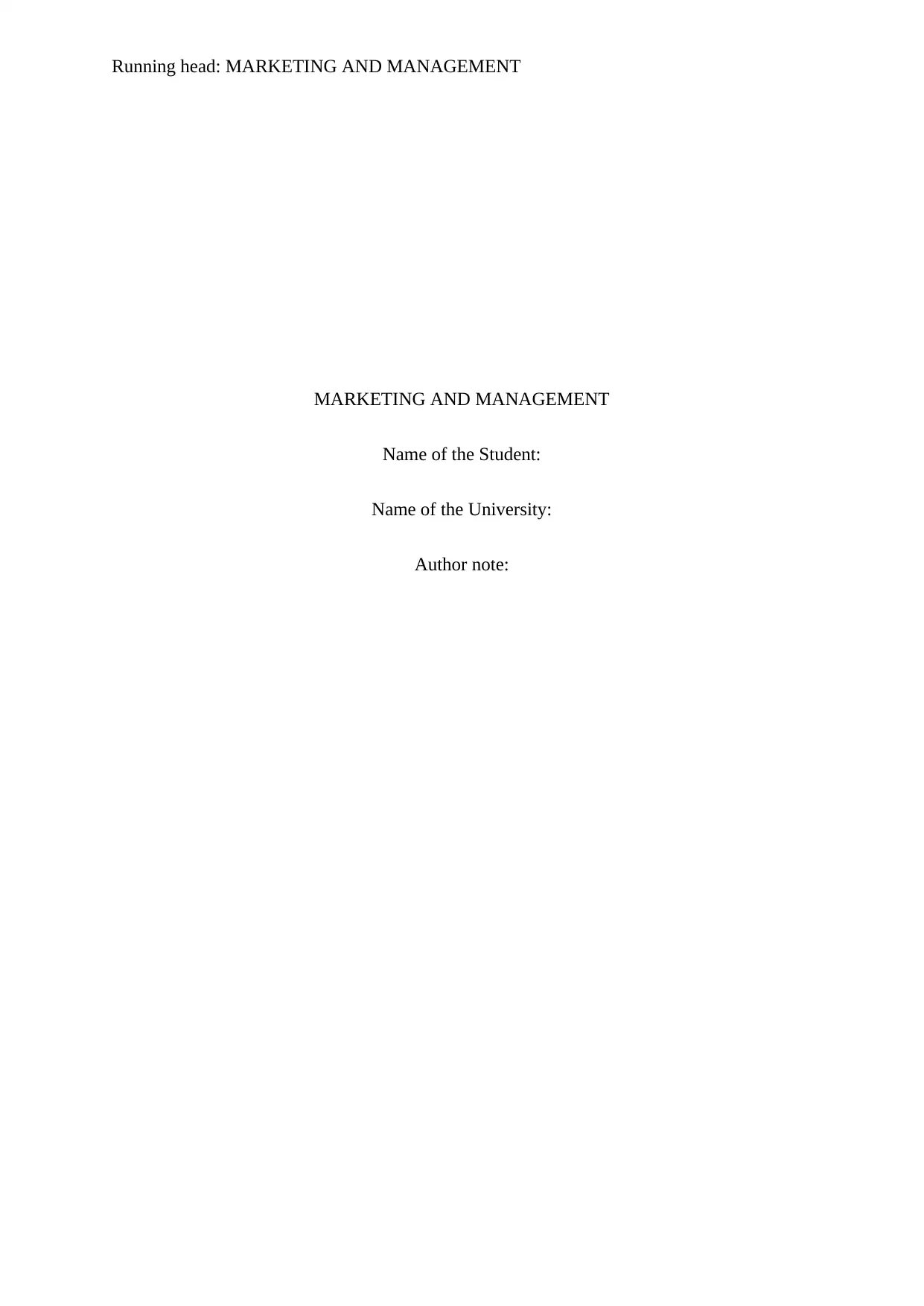
Running head: MARKETING AND MANAGEMENT
MARKETING AND MANAGEMENT
Name of the Student:
Name of the University:
Author note:
MARKETING AND MANAGEMENT
Name of the Student:
Name of the University:
Author note:
Paraphrase This Document
Need a fresh take? Get an instant paraphrase of this document with our AI Paraphraser
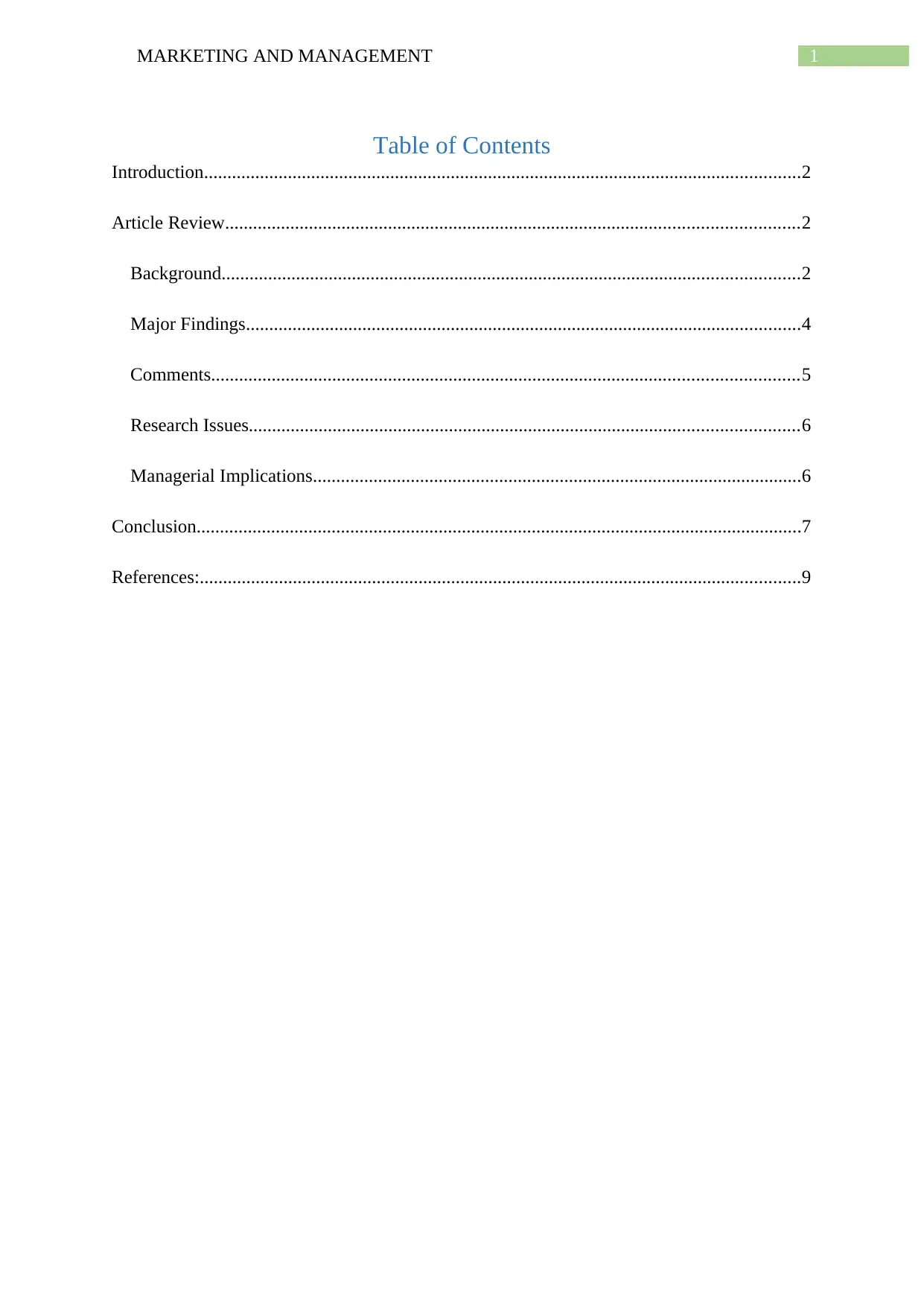
1MARKETING AND MANAGEMENT
Table of Contents
Introduction................................................................................................................................2
Article Review...........................................................................................................................2
Background............................................................................................................................2
Major Findings.......................................................................................................................4
Comments..............................................................................................................................5
Research Issues......................................................................................................................6
Managerial Implications.........................................................................................................6
Conclusion..................................................................................................................................7
References:.................................................................................................................................9
Table of Contents
Introduction................................................................................................................................2
Article Review...........................................................................................................................2
Background............................................................................................................................2
Major Findings.......................................................................................................................4
Comments..............................................................................................................................5
Research Issues......................................................................................................................6
Managerial Implications.........................................................................................................6
Conclusion..................................................................................................................................7
References:.................................................................................................................................9
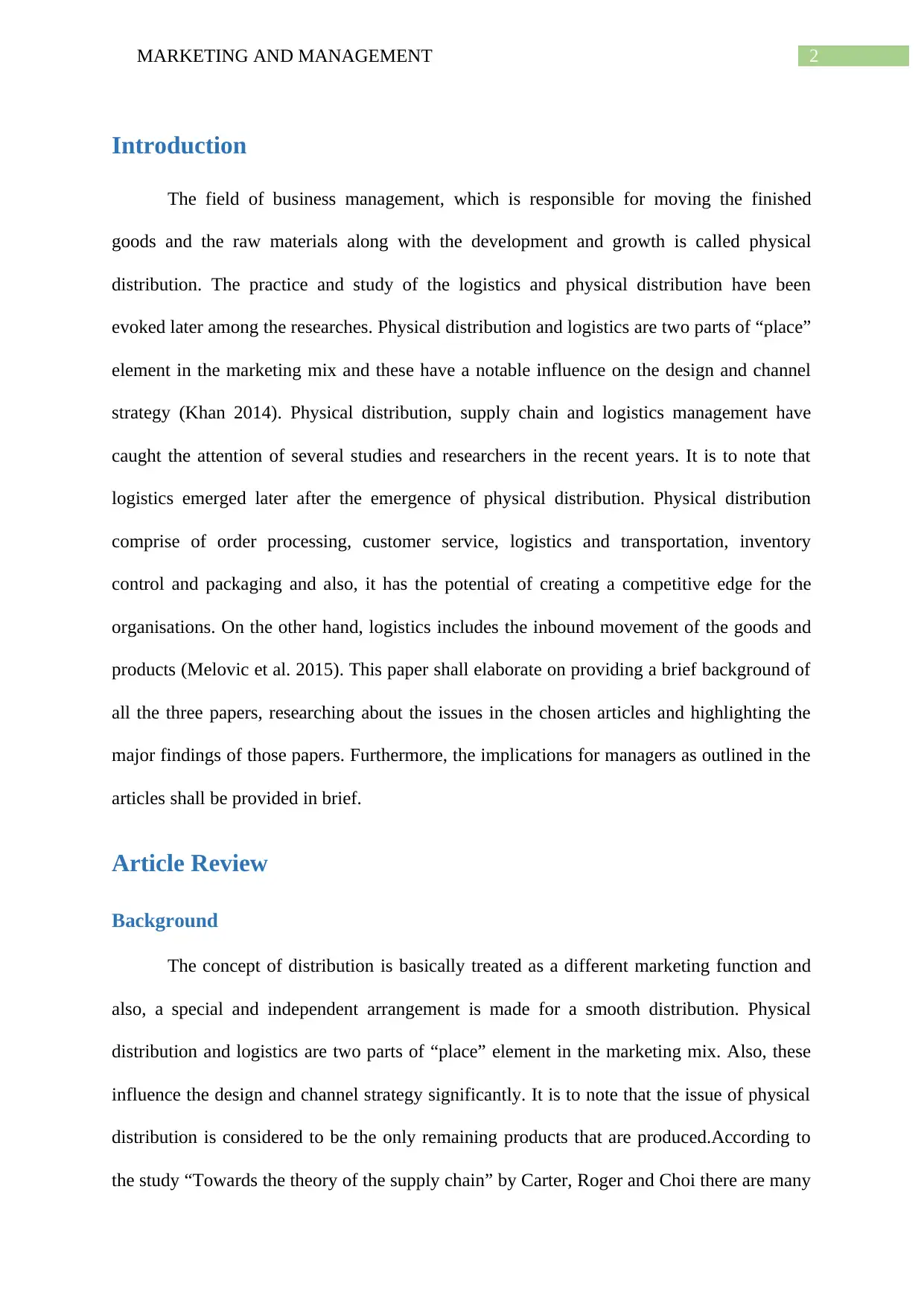
2MARKETING AND MANAGEMENT
Introduction
The field of business management, which is responsible for moving the finished
goods and the raw materials along with the development and growth is called physical
distribution. The practice and study of the logistics and physical distribution have been
evoked later among the researches. Physical distribution and logistics are two parts of “place”
element in the marketing mix and these have a notable influence on the design and channel
strategy (Khan 2014). Physical distribution, supply chain and logistics management have
caught the attention of several studies and researchers in the recent years. It is to note that
logistics emerged later after the emergence of physical distribution. Physical distribution
comprise of order processing, customer service, logistics and transportation, inventory
control and packaging and also, it has the potential of creating a competitive edge for the
organisations. On the other hand, logistics includes the inbound movement of the goods and
products (Melovic et al. 2015). This paper shall elaborate on providing a brief background of
all the three papers, researching about the issues in the chosen articles and highlighting the
major findings of those papers. Furthermore, the implications for managers as outlined in the
articles shall be provided in brief.
Article Review
Background
The concept of distribution is basically treated as a different marketing function and
also, a special and independent arrangement is made for a smooth distribution. Physical
distribution and logistics are two parts of “place” element in the marketing mix. Also, these
influence the design and channel strategy significantly. It is to note that the issue of physical
distribution is considered to be the only remaining products that are produced.According to
the study “Towards the theory of the supply chain” by Carter, Roger and Choi there are many
Introduction
The field of business management, which is responsible for moving the finished
goods and the raw materials along with the development and growth is called physical
distribution. The practice and study of the logistics and physical distribution have been
evoked later among the researches. Physical distribution and logistics are two parts of “place”
element in the marketing mix and these have a notable influence on the design and channel
strategy (Khan 2014). Physical distribution, supply chain and logistics management have
caught the attention of several studies and researchers in the recent years. It is to note that
logistics emerged later after the emergence of physical distribution. Physical distribution
comprise of order processing, customer service, logistics and transportation, inventory
control and packaging and also, it has the potential of creating a competitive edge for the
organisations. On the other hand, logistics includes the inbound movement of the goods and
products (Melovic et al. 2015). This paper shall elaborate on providing a brief background of
all the three papers, researching about the issues in the chosen articles and highlighting the
major findings of those papers. Furthermore, the implications for managers as outlined in the
articles shall be provided in brief.
Article Review
Background
The concept of distribution is basically treated as a different marketing function and
also, a special and independent arrangement is made for a smooth distribution. Physical
distribution and logistics are two parts of “place” element in the marketing mix. Also, these
influence the design and channel strategy significantly. It is to note that the issue of physical
distribution is considered to be the only remaining products that are produced.According to
the study “Towards the theory of the supply chain” by Carter, Roger and Choi there are many
⊘ This is a preview!⊘
Do you want full access?
Subscribe today to unlock all pages.

Trusted by 1+ million students worldwide
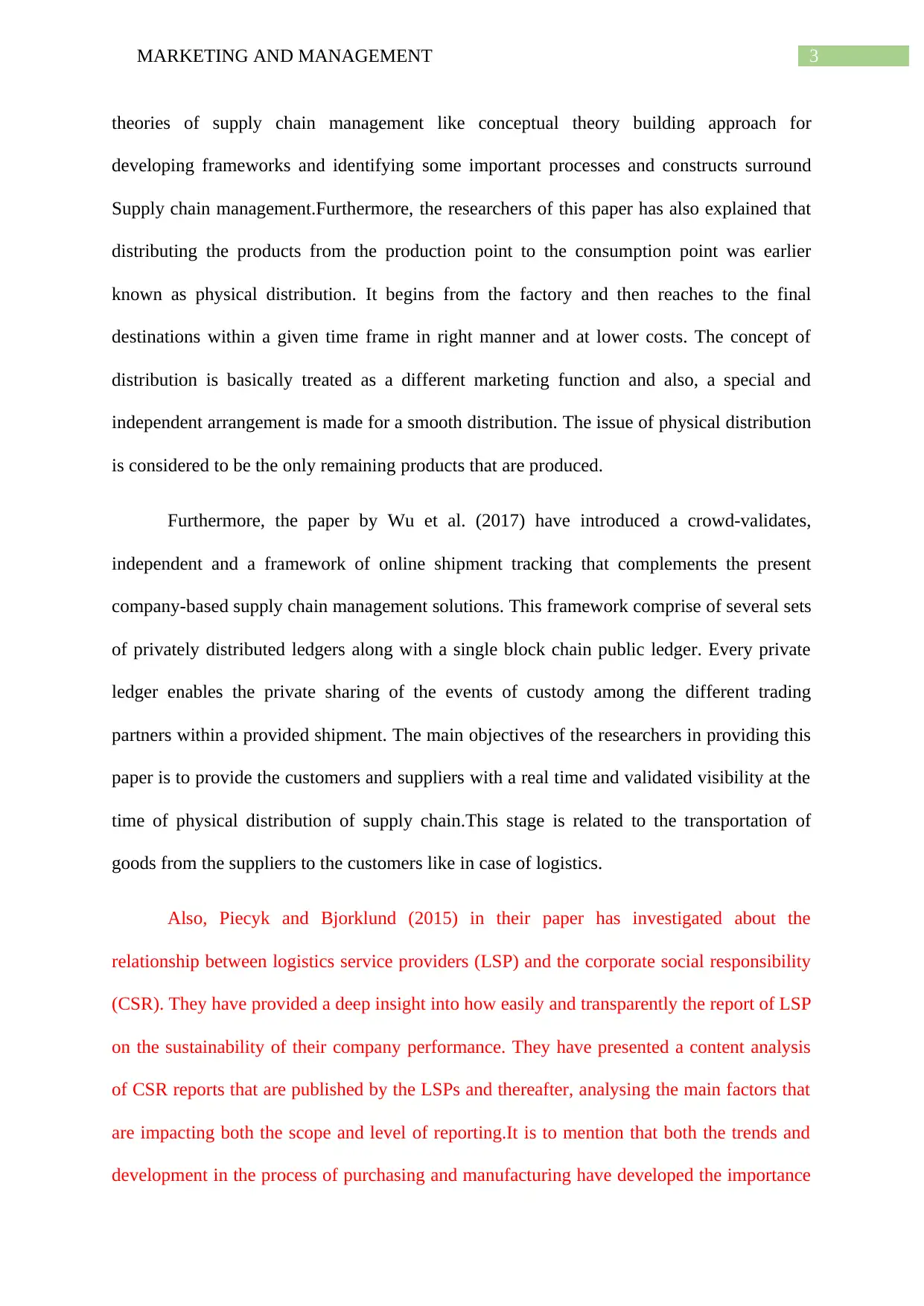
3MARKETING AND MANAGEMENT
theories of supply chain management like conceptual theory building approach for
developing frameworks and identifying some important processes and constructs surround
Supply chain management.Furthermore, the researchers of this paper has also explained that
distributing the products from the production point to the consumption point was earlier
known as physical distribution. It begins from the factory and then reaches to the final
destinations within a given time frame in right manner and at lower costs. The concept of
distribution is basically treated as a different marketing function and also, a special and
independent arrangement is made for a smooth distribution. The issue of physical distribution
is considered to be the only remaining products that are produced.
Furthermore, the paper by Wu et al. (2017) have introduced a crowd-validates,
independent and a framework of online shipment tracking that complements the present
company-based supply chain management solutions. This framework comprise of several sets
of privately distributed ledgers along with a single block chain public ledger. Every private
ledger enables the private sharing of the events of custody among the different trading
partners within a provided shipment. The main objectives of the researchers in providing this
paper is to provide the customers and suppliers with a real time and validated visibility at the
time of physical distribution of supply chain.This stage is related to the transportation of
goods from the suppliers to the customers like in case of logistics.
Also, Piecyk and Bjorklund (2015) in their paper has investigated about the
relationship between logistics service providers (LSP) and the corporate social responsibility
(CSR). They have provided a deep insight into how easily and transparently the report of LSP
on the sustainability of their company performance. They have presented a content analysis
of CSR reports that are published by the LSPs and thereafter, analysing the main factors that
are impacting both the scope and level of reporting.It is to mention that both the trends and
development in the process of purchasing and manufacturing have developed the importance
theories of supply chain management like conceptual theory building approach for
developing frameworks and identifying some important processes and constructs surround
Supply chain management.Furthermore, the researchers of this paper has also explained that
distributing the products from the production point to the consumption point was earlier
known as physical distribution. It begins from the factory and then reaches to the final
destinations within a given time frame in right manner and at lower costs. The concept of
distribution is basically treated as a different marketing function and also, a special and
independent arrangement is made for a smooth distribution. The issue of physical distribution
is considered to be the only remaining products that are produced.
Furthermore, the paper by Wu et al. (2017) have introduced a crowd-validates,
independent and a framework of online shipment tracking that complements the present
company-based supply chain management solutions. This framework comprise of several sets
of privately distributed ledgers along with a single block chain public ledger. Every private
ledger enables the private sharing of the events of custody among the different trading
partners within a provided shipment. The main objectives of the researchers in providing this
paper is to provide the customers and suppliers with a real time and validated visibility at the
time of physical distribution of supply chain.This stage is related to the transportation of
goods from the suppliers to the customers like in case of logistics.
Also, Piecyk and Bjorklund (2015) in their paper has investigated about the
relationship between logistics service providers (LSP) and the corporate social responsibility
(CSR). They have provided a deep insight into how easily and transparently the report of LSP
on the sustainability of their company performance. They have presented a content analysis
of CSR reports that are published by the LSPs and thereafter, analysing the main factors that
are impacting both the scope and level of reporting.It is to mention that both the trends and
development in the process of purchasing and manufacturing have developed the importance
Paraphrase This Document
Need a fresh take? Get an instant paraphrase of this document with our AI Paraphraser
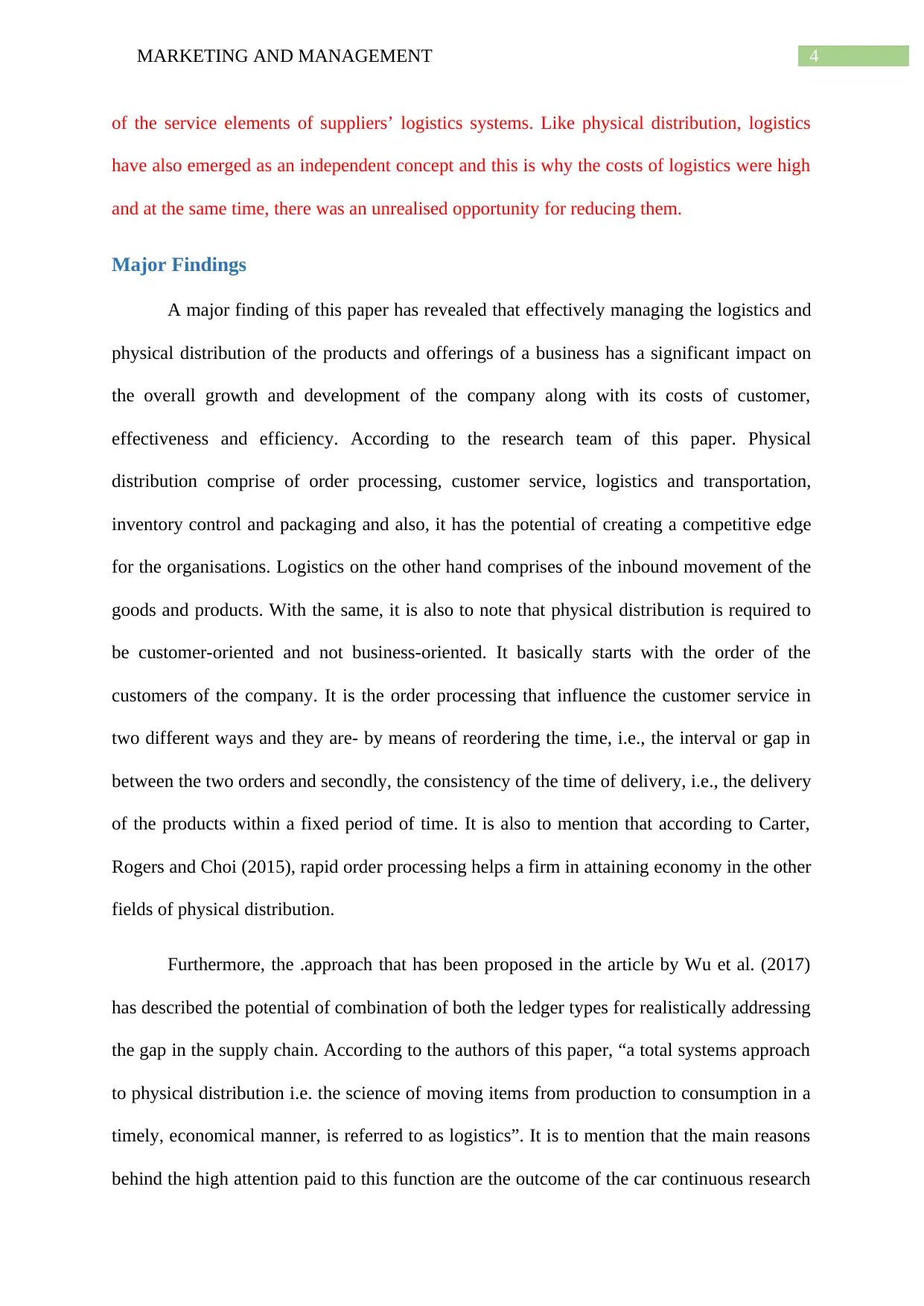
4MARKETING AND MANAGEMENT
of the service elements of suppliers’ logistics systems. Like physical distribution, logistics
have also emerged as an independent concept and this is why the costs of logistics were high
and at the same time, there was an unrealised opportunity for reducing them.
Major Findings
A major finding of this paper has revealed that effectively managing the logistics and
physical distribution of the products and offerings of a business has a significant impact on
the overall growth and development of the company along with its costs of customer,
effectiveness and efficiency. According to the research team of this paper. Physical
distribution comprise of order processing, customer service, logistics and transportation,
inventory control and packaging and also, it has the potential of creating a competitive edge
for the organisations. Logistics on the other hand comprises of the inbound movement of the
goods and products. With the same, it is also to note that physical distribution is required to
be customer-oriented and not business-oriented. It basically starts with the order of the
customers of the company. It is the order processing that influence the customer service in
two different ways and they are- by means of reordering the time, i.e., the interval or gap in
between the two orders and secondly, the consistency of the time of delivery, i.e., the delivery
of the products within a fixed period of time. It is also to mention that according to Carter,
Rogers and Choi (2015), rapid order processing helps a firm in attaining economy in the other
fields of physical distribution.
Furthermore, the .approach that has been proposed in the article by Wu et al. (2017)
has described the potential of combination of both the ledger types for realistically addressing
the gap in the supply chain. According to the authors of this paper, “a total systems approach
to physical distribution i.e. the science of moving items from production to consumption in a
timely, economical manner, is referred to as logistics”. It is to mention that the main reasons
behind the high attention paid to this function are the outcome of the car continuous research
of the service elements of suppliers’ logistics systems. Like physical distribution, logistics
have also emerged as an independent concept and this is why the costs of logistics were high
and at the same time, there was an unrealised opportunity for reducing them.
Major Findings
A major finding of this paper has revealed that effectively managing the logistics and
physical distribution of the products and offerings of a business has a significant impact on
the overall growth and development of the company along with its costs of customer,
effectiveness and efficiency. According to the research team of this paper. Physical
distribution comprise of order processing, customer service, logistics and transportation,
inventory control and packaging and also, it has the potential of creating a competitive edge
for the organisations. Logistics on the other hand comprises of the inbound movement of the
goods and products. With the same, it is also to note that physical distribution is required to
be customer-oriented and not business-oriented. It basically starts with the order of the
customers of the company. It is the order processing that influence the customer service in
two different ways and they are- by means of reordering the time, i.e., the interval or gap in
between the two orders and secondly, the consistency of the time of delivery, i.e., the delivery
of the products within a fixed period of time. It is also to mention that according to Carter,
Rogers and Choi (2015), rapid order processing helps a firm in attaining economy in the other
fields of physical distribution.
Furthermore, the .approach that has been proposed in the article by Wu et al. (2017)
has described the potential of combination of both the ledger types for realistically addressing
the gap in the supply chain. According to the authors of this paper, “a total systems approach
to physical distribution i.e. the science of moving items from production to consumption in a
timely, economical manner, is referred to as logistics”. It is to mention that the main reasons
behind the high attention paid to this function are the outcome of the car continuous research
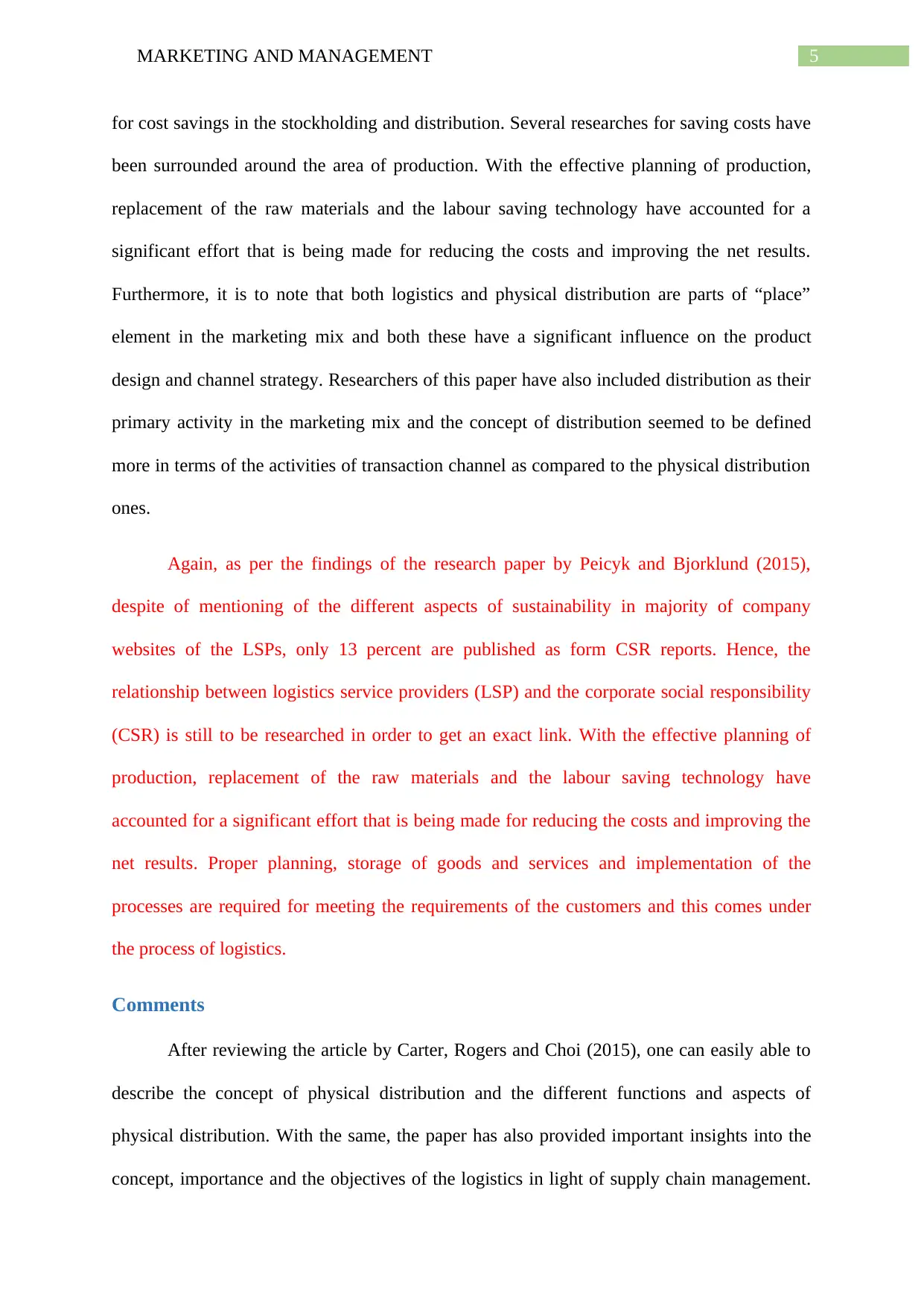
5MARKETING AND MANAGEMENT
for cost savings in the stockholding and distribution. Several researches for saving costs have
been surrounded around the area of production. With the effective planning of production,
replacement of the raw materials and the labour saving technology have accounted for a
significant effort that is being made for reducing the costs and improving the net results.
Furthermore, it is to note that both logistics and physical distribution are parts of “place”
element in the marketing mix and both these have a significant influence on the product
design and channel strategy. Researchers of this paper have also included distribution as their
primary activity in the marketing mix and the concept of distribution seemed to be defined
more in terms of the activities of transaction channel as compared to the physical distribution
ones.
Again, as per the findings of the research paper by Peicyk and Bjorklund (2015),
despite of mentioning of the different aspects of sustainability in majority of company
websites of the LSPs, only 13 percent are published as form CSR reports. Hence, the
relationship between logistics service providers (LSP) and the corporate social responsibility
(CSR) is still to be researched in order to get an exact link. With the effective planning of
production, replacement of the raw materials and the labour saving technology have
accounted for a significant effort that is being made for reducing the costs and improving the
net results. Proper planning, storage of goods and services and implementation of the
processes are required for meeting the requirements of the customers and this comes under
the process of logistics.
Comments
After reviewing the article by Carter, Rogers and Choi (2015), one can easily able to
describe the concept of physical distribution and the different functions and aspects of
physical distribution. With the same, the paper has also provided important insights into the
concept, importance and the objectives of the logistics in light of supply chain management.
for cost savings in the stockholding and distribution. Several researches for saving costs have
been surrounded around the area of production. With the effective planning of production,
replacement of the raw materials and the labour saving technology have accounted for a
significant effort that is being made for reducing the costs and improving the net results.
Furthermore, it is to note that both logistics and physical distribution are parts of “place”
element in the marketing mix and both these have a significant influence on the product
design and channel strategy. Researchers of this paper have also included distribution as their
primary activity in the marketing mix and the concept of distribution seemed to be defined
more in terms of the activities of transaction channel as compared to the physical distribution
ones.
Again, as per the findings of the research paper by Peicyk and Bjorklund (2015),
despite of mentioning of the different aspects of sustainability in majority of company
websites of the LSPs, only 13 percent are published as form CSR reports. Hence, the
relationship between logistics service providers (LSP) and the corporate social responsibility
(CSR) is still to be researched in order to get an exact link. With the effective planning of
production, replacement of the raw materials and the labour saving technology have
accounted for a significant effort that is being made for reducing the costs and improving the
net results. Proper planning, storage of goods and services and implementation of the
processes are required for meeting the requirements of the customers and this comes under
the process of logistics.
Comments
After reviewing the article by Carter, Rogers and Choi (2015), one can easily able to
describe the concept of physical distribution and the different functions and aspects of
physical distribution. With the same, the paper has also provided important insights into the
concept, importance and the objectives of the logistics in light of supply chain management.
⊘ This is a preview!⊘
Do you want full access?
Subscribe today to unlock all pages.

Trusted by 1+ million students worldwide
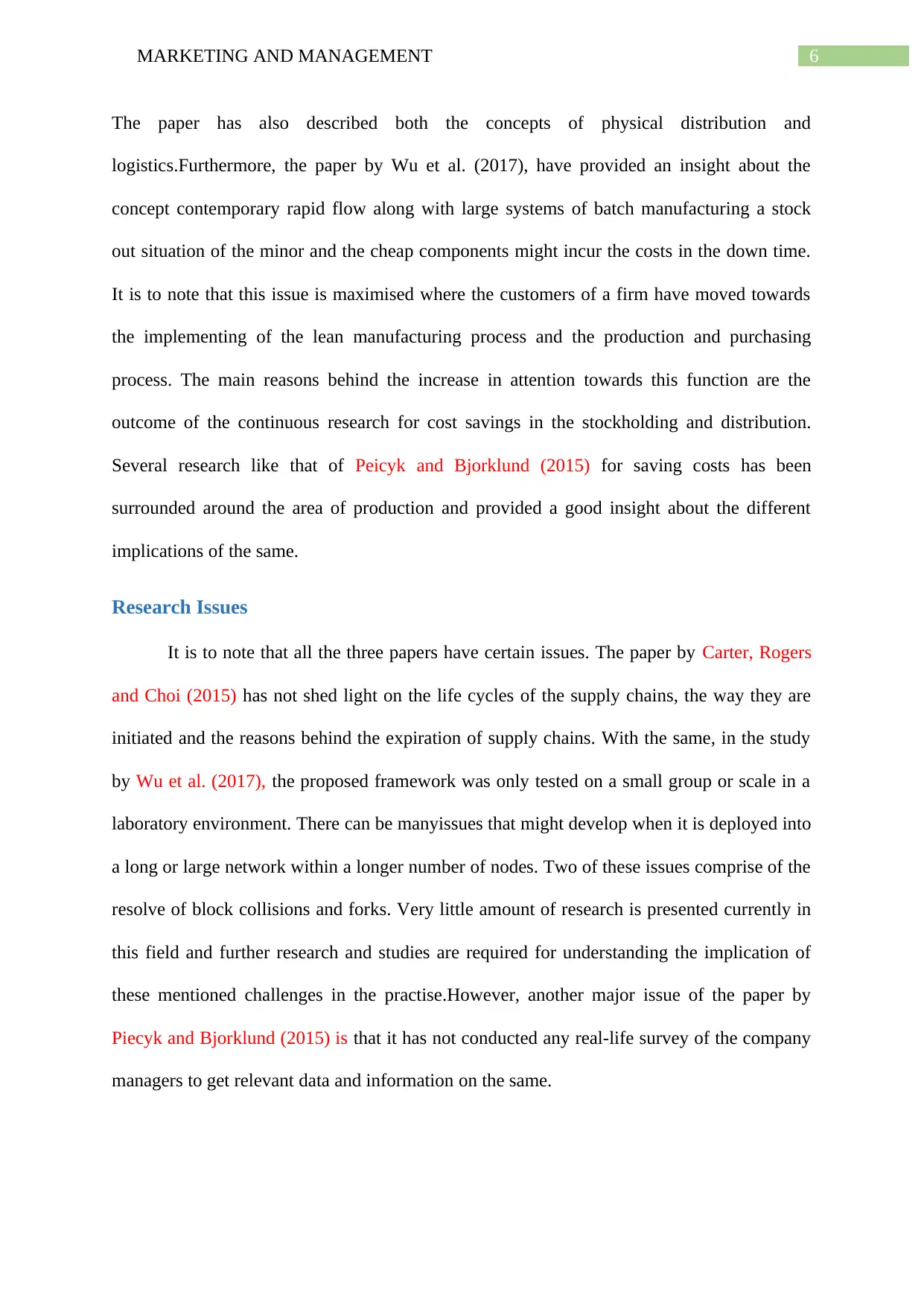
6MARKETING AND MANAGEMENT
The paper has also described both the concepts of physical distribution and
logistics.Furthermore, the paper by Wu et al. (2017), have provided an insight about the
concept contemporary rapid flow along with large systems of batch manufacturing a stock
out situation of the minor and the cheap components might incur the costs in the down time.
It is to note that this issue is maximised where the customers of a firm have moved towards
the implementing of the lean manufacturing process and the production and purchasing
process. The main reasons behind the increase in attention towards this function are the
outcome of the continuous research for cost savings in the stockholding and distribution.
Several research like that of Peicyk and Bjorklund (2015) for saving costs has been
surrounded around the area of production and provided a good insight about the different
implications of the same.
Research Issues
It is to note that all the three papers have certain issues. The paper by Carter, Rogers
and Choi (2015) has not shed light on the life cycles of the supply chains, the way they are
initiated and the reasons behind the expiration of supply chains. With the same, in the study
by Wu et al. (2017), the proposed framework was only tested on a small group or scale in a
laboratory environment. There can be manyissues that might develop when it is deployed into
a long or large network within a longer number of nodes. Two of these issues comprise of the
resolve of block collisions and forks. Very little amount of research is presented currently in
this field and further research and studies are required for understanding the implication of
these mentioned challenges in the practise.However, another major issue of the paper by
Piecyk and Bjorklund (2015) is that it has not conducted any real-life survey of the company
managers to get relevant data and information on the same.
The paper has also described both the concepts of physical distribution and
logistics.Furthermore, the paper by Wu et al. (2017), have provided an insight about the
concept contemporary rapid flow along with large systems of batch manufacturing a stock
out situation of the minor and the cheap components might incur the costs in the down time.
It is to note that this issue is maximised where the customers of a firm have moved towards
the implementing of the lean manufacturing process and the production and purchasing
process. The main reasons behind the increase in attention towards this function are the
outcome of the continuous research for cost savings in the stockholding and distribution.
Several research like that of Peicyk and Bjorklund (2015) for saving costs has been
surrounded around the area of production and provided a good insight about the different
implications of the same.
Research Issues
It is to note that all the three papers have certain issues. The paper by Carter, Rogers
and Choi (2015) has not shed light on the life cycles of the supply chains, the way they are
initiated and the reasons behind the expiration of supply chains. With the same, in the study
by Wu et al. (2017), the proposed framework was only tested on a small group or scale in a
laboratory environment. There can be manyissues that might develop when it is deployed into
a long or large network within a longer number of nodes. Two of these issues comprise of the
resolve of block collisions and forks. Very little amount of research is presented currently in
this field and further research and studies are required for understanding the implication of
these mentioned challenges in the practise.However, another major issue of the paper by
Piecyk and Bjorklund (2015) is that it has not conducted any real-life survey of the company
managers to get relevant data and information on the same.
Paraphrase This Document
Need a fresh take? Get an instant paraphrase of this document with our AI Paraphraser
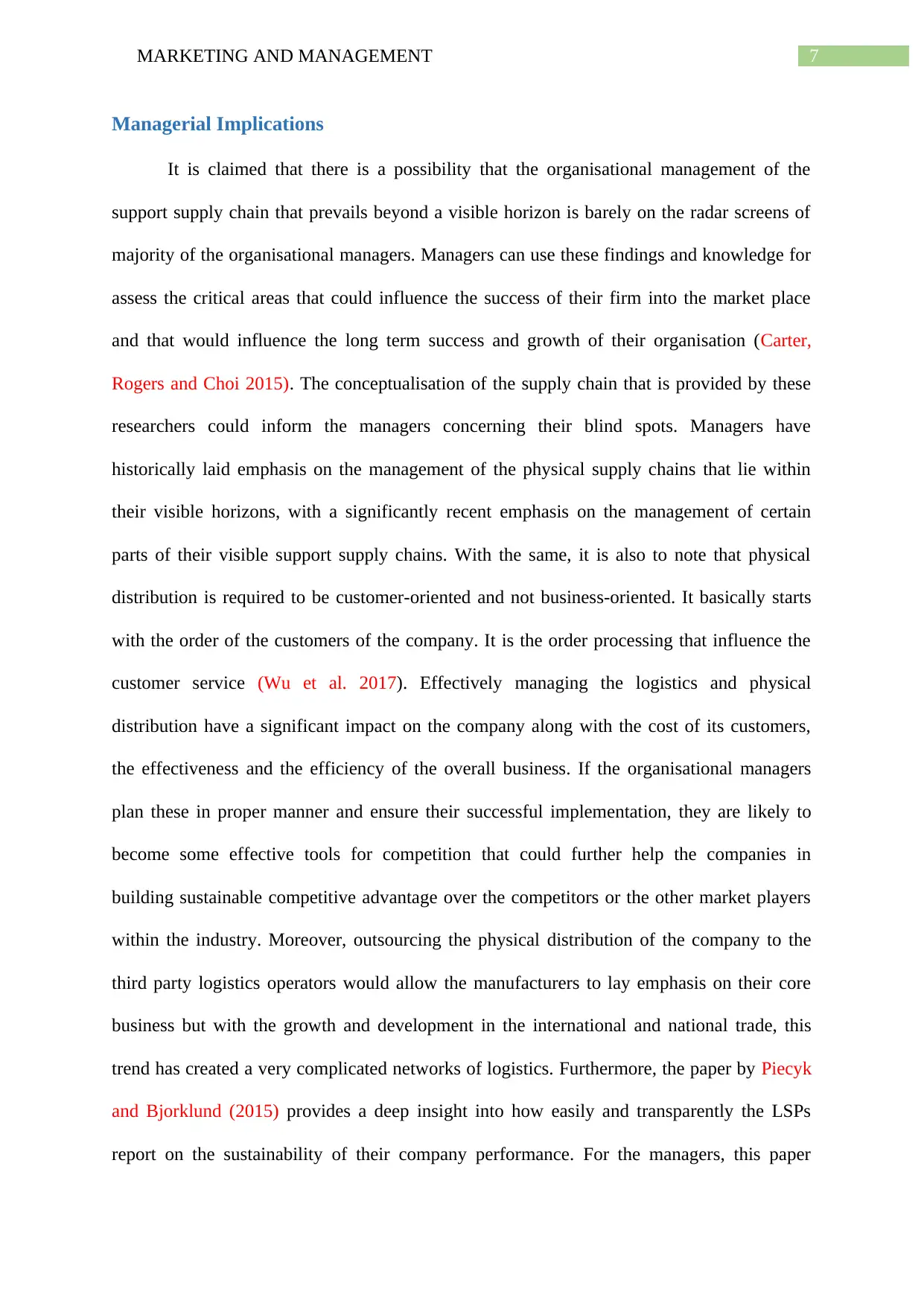
7MARKETING AND MANAGEMENT
Managerial Implications
It is claimed that there is a possibility that the organisational management of the
support supply chain that prevails beyond a visible horizon is barely on the radar screens of
majority of the organisational managers. Managers can use these findings and knowledge for
assess the critical areas that could influence the success of their firm into the market place
and that would influence the long term success and growth of their organisation (Carter,
Rogers and Choi 2015). The conceptualisation of the supply chain that is provided by these
researchers could inform the managers concerning their blind spots. Managers have
historically laid emphasis on the management of the physical supply chains that lie within
their visible horizons, with a significantly recent emphasis on the management of certain
parts of their visible support supply chains. With the same, it is also to note that physical
distribution is required to be customer-oriented and not business-oriented. It basically starts
with the order of the customers of the company. It is the order processing that influence the
customer service (Wu et al. 2017). Effectively managing the logistics and physical
distribution have a significant impact on the company along with the cost of its customers,
the effectiveness and the efficiency of the overall business. If the organisational managers
plan these in proper manner and ensure their successful implementation, they are likely to
become some effective tools for competition that could further help the companies in
building sustainable competitive advantage over the competitors or the other market players
within the industry. Moreover, outsourcing the physical distribution of the company to the
third party logistics operators would allow the manufacturers to lay emphasis on their core
business but with the growth and development in the international and national trade, this
trend has created a very complicated networks of logistics. Furthermore, the paper by Piecyk
and Bjorklund (2015) provides a deep insight into how easily and transparently the LSPs
report on the sustainability of their company performance. For the managers, this paper
Managerial Implications
It is claimed that there is a possibility that the organisational management of the
support supply chain that prevails beyond a visible horizon is barely on the radar screens of
majority of the organisational managers. Managers can use these findings and knowledge for
assess the critical areas that could influence the success of their firm into the market place
and that would influence the long term success and growth of their organisation (Carter,
Rogers and Choi 2015). The conceptualisation of the supply chain that is provided by these
researchers could inform the managers concerning their blind spots. Managers have
historically laid emphasis on the management of the physical supply chains that lie within
their visible horizons, with a significantly recent emphasis on the management of certain
parts of their visible support supply chains. With the same, it is also to note that physical
distribution is required to be customer-oriented and not business-oriented. It basically starts
with the order of the customers of the company. It is the order processing that influence the
customer service (Wu et al. 2017). Effectively managing the logistics and physical
distribution have a significant impact on the company along with the cost of its customers,
the effectiveness and the efficiency of the overall business. If the organisational managers
plan these in proper manner and ensure their successful implementation, they are likely to
become some effective tools for competition that could further help the companies in
building sustainable competitive advantage over the competitors or the other market players
within the industry. Moreover, outsourcing the physical distribution of the company to the
third party logistics operators would allow the manufacturers to lay emphasis on their core
business but with the growth and development in the international and national trade, this
trend has created a very complicated networks of logistics. Furthermore, the paper by Piecyk
and Bjorklund (2015) provides a deep insight into how easily and transparently the LSPs
report on the sustainability of their company performance. For the managers, this paper
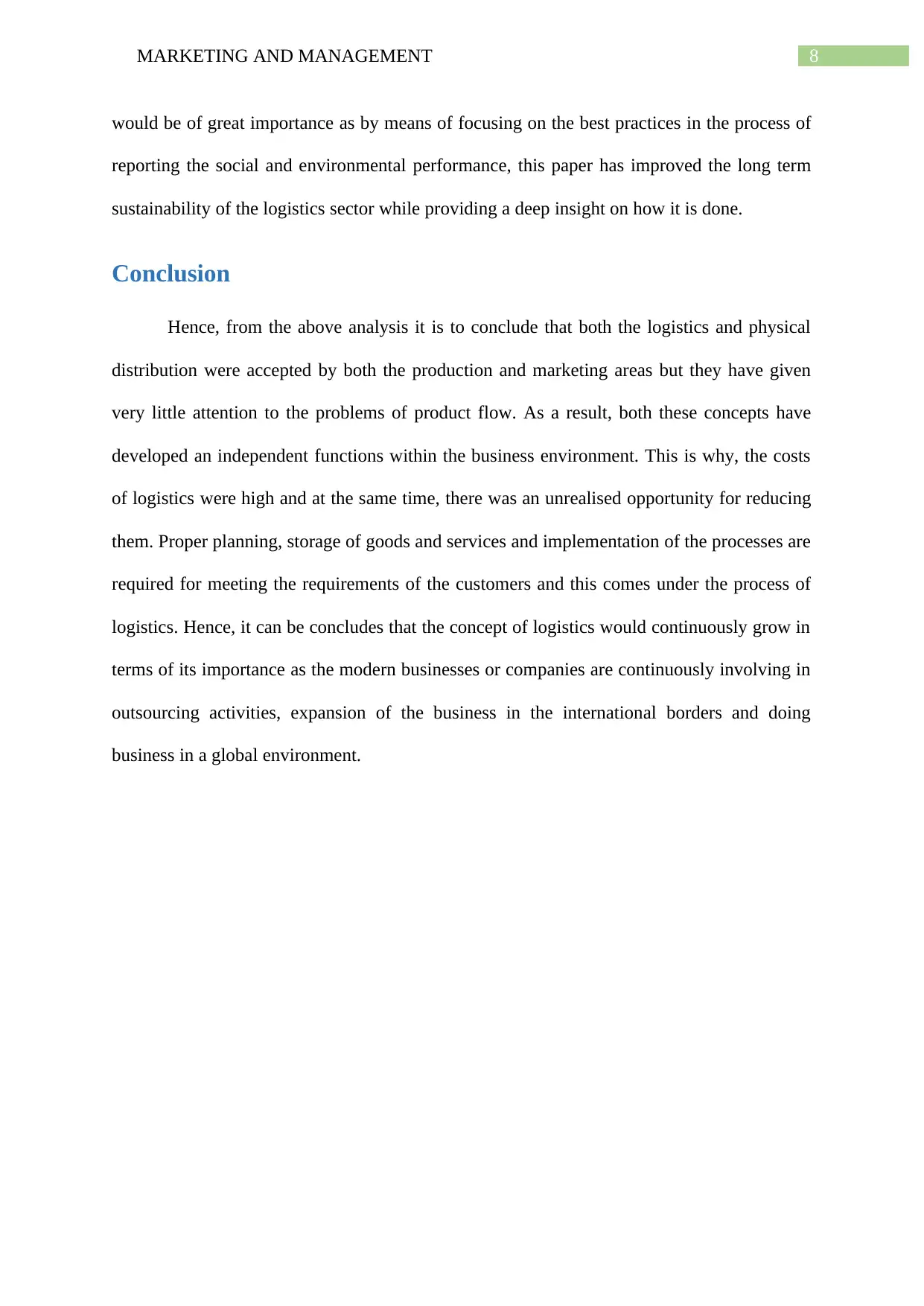
8MARKETING AND MANAGEMENT
would be of great importance as by means of focusing on the best practices in the process of
reporting the social and environmental performance, this paper has improved the long term
sustainability of the logistics sector while providing a deep insight on how it is done.
Conclusion
Hence, from the above analysis it is to conclude that both the logistics and physical
distribution were accepted by both the production and marketing areas but they have given
very little attention to the problems of product flow. As a result, both these concepts have
developed an independent functions within the business environment. This is why, the costs
of logistics were high and at the same time, there was an unrealised opportunity for reducing
them. Proper planning, storage of goods and services and implementation of the processes are
required for meeting the requirements of the customers and this comes under the process of
logistics. Hence, it can be concludes that the concept of logistics would continuously grow in
terms of its importance as the modern businesses or companies are continuously involving in
outsourcing activities, expansion of the business in the international borders and doing
business in a global environment.
would be of great importance as by means of focusing on the best practices in the process of
reporting the social and environmental performance, this paper has improved the long term
sustainability of the logistics sector while providing a deep insight on how it is done.
Conclusion
Hence, from the above analysis it is to conclude that both the logistics and physical
distribution were accepted by both the production and marketing areas but they have given
very little attention to the problems of product flow. As a result, both these concepts have
developed an independent functions within the business environment. This is why, the costs
of logistics were high and at the same time, there was an unrealised opportunity for reducing
them. Proper planning, storage of goods and services and implementation of the processes are
required for meeting the requirements of the customers and this comes under the process of
logistics. Hence, it can be concludes that the concept of logistics would continuously grow in
terms of its importance as the modern businesses or companies are continuously involving in
outsourcing activities, expansion of the business in the international borders and doing
business in a global environment.
⊘ This is a preview!⊘
Do you want full access?
Subscribe today to unlock all pages.

Trusted by 1+ million students worldwide
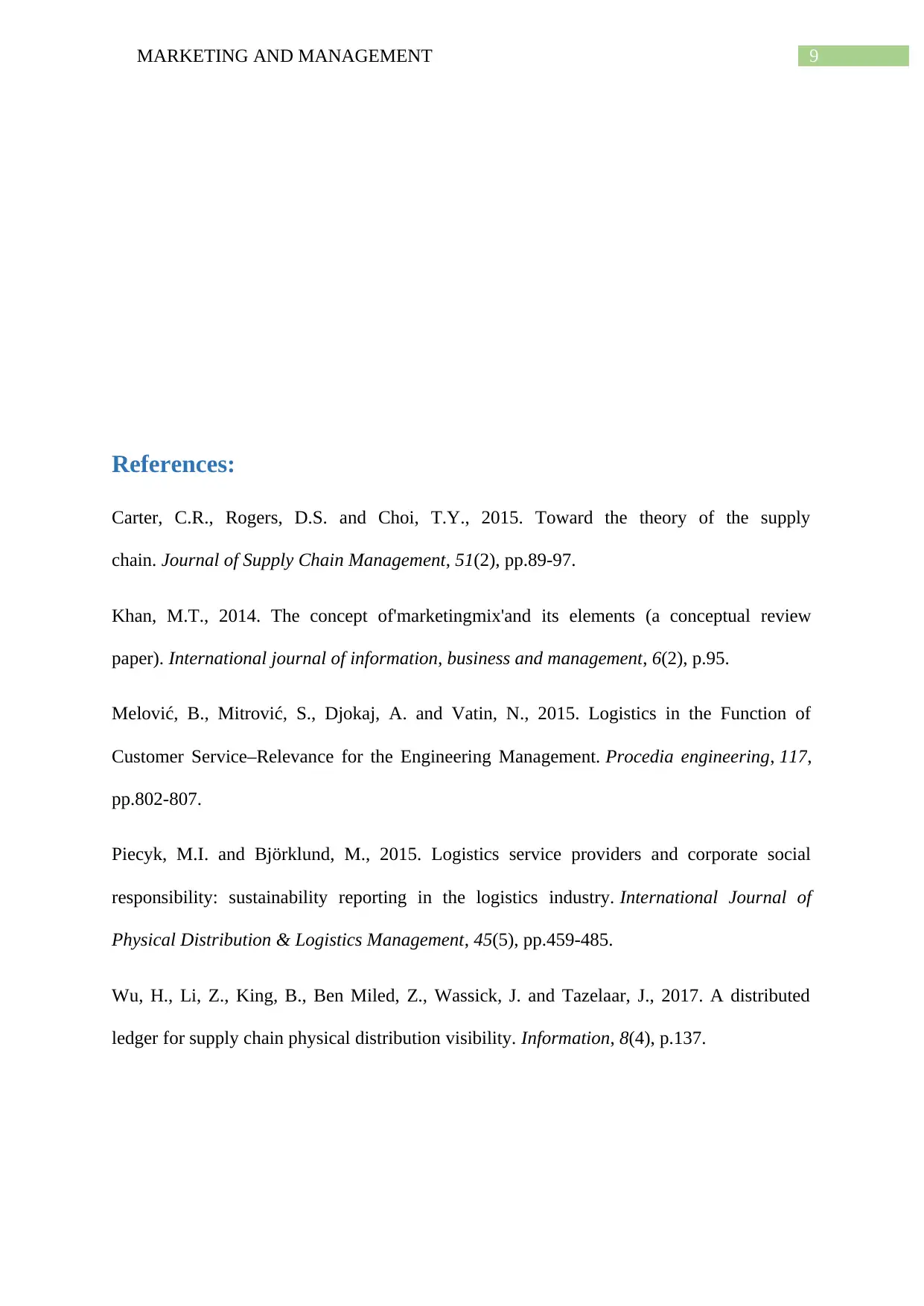
9MARKETING AND MANAGEMENT
References:
Carter, C.R., Rogers, D.S. and Choi, T.Y., 2015. Toward the theory of the supply
chain. Journal of Supply Chain Management, 51(2), pp.89-97.
Khan, M.T., 2014. The concept of'marketingmix'and its elements (a conceptual review
paper). International journal of information, business and management, 6(2), p.95.
Melović, B., Mitrović, S., Djokaj, A. and Vatin, N., 2015. Logistics in the Function of
Customer Service–Relevance for the Engineering Management. Procedia engineering, 117,
pp.802-807.
Piecyk, M.I. and Björklund, M., 2015. Logistics service providers and corporate social
responsibility: sustainability reporting in the logistics industry. International Journal of
Physical Distribution & Logistics Management, 45(5), pp.459-485.
Wu, H., Li, Z., King, B., Ben Miled, Z., Wassick, J. and Tazelaar, J., 2017. A distributed
ledger for supply chain physical distribution visibility. Information, 8(4), p.137.
References:
Carter, C.R., Rogers, D.S. and Choi, T.Y., 2015. Toward the theory of the supply
chain. Journal of Supply Chain Management, 51(2), pp.89-97.
Khan, M.T., 2014. The concept of'marketingmix'and its elements (a conceptual review
paper). International journal of information, business and management, 6(2), p.95.
Melović, B., Mitrović, S., Djokaj, A. and Vatin, N., 2015. Logistics in the Function of
Customer Service–Relevance for the Engineering Management. Procedia engineering, 117,
pp.802-807.
Piecyk, M.I. and Björklund, M., 2015. Logistics service providers and corporate social
responsibility: sustainability reporting in the logistics industry. International Journal of
Physical Distribution & Logistics Management, 45(5), pp.459-485.
Wu, H., Li, Z., King, B., Ben Miled, Z., Wassick, J. and Tazelaar, J., 2017. A distributed
ledger for supply chain physical distribution visibility. Information, 8(4), p.137.
1 out of 10
Related Documents
Your All-in-One AI-Powered Toolkit for Academic Success.
+13062052269
info@desklib.com
Available 24*7 on WhatsApp / Email
![[object Object]](/_next/static/media/star-bottom.7253800d.svg)
Unlock your academic potential
Copyright © 2020–2025 A2Z Services. All Rights Reserved. Developed and managed by ZUCOL.





